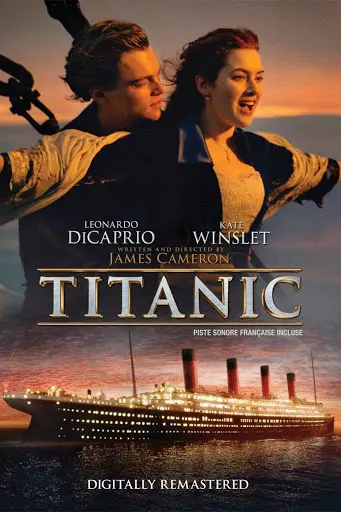James Cameron’s Titanic (1997) is one of the most iconic films in cinematic history, blending romance, historical drama, and unforgettable spectacle. The film takes audiences on a breathtaking journey through the ill-fated voyage of the RMS Titanic, capturing both the grandeur of the ship and the tragic events that unfolded during its maiden voyage. But beyond the historical disaster, Titanic is a deeply emotional story of love, loss, and survival, set against the backdrop of one of the most significant maritime tragedies of the 20th century.

Plot Overview
The story of Titanic is centered around the ill-fated voyage of the RMS Titanic, which struck an iceberg and sank on its maiden voyage in 1912. The narrative unfolds through the eyes of an elderly Rose DeWitt Bukater (played by Gloria Stuart), who recounts her experience aboard the ship to treasure hunter Brock Lovett (Bill Paxton) and his crew, who are searching for a priceless diamond known as the Heart of the Ocean.
In a series of flashbacks, Rose recalls her time as a young woman (Kate Winslet), traveling aboard the Titanic with her wealthy fiancé, Cal Hockley (Billy Zane), and her overbearing mother, Ruth (Frances Fisher). It is on this ship that Rose meets Jack Dawson (Leonardo DiCaprio), a penniless artist who wins a ticket aboard the Titanic in a poker game. The two form an intense and passionate bond, despite the social and class differences that separate them.
As the Titanic sails across the Atlantic, Jack and Rose’s love story blossoms amid the luxurious surroundings of the ship. However, their romance is cut short when disaster strikes. The ship collides with an iceberg, and the film shifts from a love story to a heart-wrenching tale of survival as passengers and crew scramble to escape the sinking ship.
Characters and Performances
The heart of Titanic lies in the performances of Leonardo DiCaprio and Kate Winslet, whose portrayal of Jack and Rose remains iconic. DiCaprio’s Jack is a free-spirited, charming artist whose love for Rose transcends the social divides of class. Winslet’s Rose is strong-willed, intelligent, and unafraid to challenge societal expectations, which makes her an empowering character for many viewers. Their chemistry is palpable, and their relationship feels both deeply personal and universally relatable.
Supporting characters such as Billy Zane’s Cal, the possessive and arrogant fiancé, and Kathy Bates’ Molly Brown, a self-made millionaire with a heart of gold, add layers to the film. Bates’ portrayal of Molly, in particular, offers a dose of humor and humanity in contrast to the unfolding tragedy.
Visuals and Special Effects
Titanic is known for its incredible visual spectacle, from the grandeur of the ship to the harrowing depiction of its sinking. The film’s set design, costumes, and attention to historical detail transport viewers back to the early 20th century. The recreation of the Titanic is a technical marvel, and its sinking—portrayed with state-of-the-art special effects—remains one of the most memorable and emotionally charged sequences in cinema.
The film also uses its visuals to enhance the emotional impact of the story. The beauty of the Titanic, the luxury of its interiors, and the opulence of the passengers’ lives are juxtaposed with the horror of the disaster, creating a powerful contrast that makes the film’s tragic moments even more poignant.
Themes
At its core, Titanic explores themes of love, class, and fate. The romance between Jack and Rose is a central theme, representing the triumph of love against the constraints of society and class. Their relationship serves as a metaphor for the eternal struggle between love and the rigid structures of social expectations.
The film also touches on themes of sacrifice and survival. As the Titanic sinks, characters are faced with life-or-death decisions that reflect their true nature. Jack’s selfless actions, particularly in ensuring Rose’s survival, highlight the idea of personal sacrifice for the sake of others.
Additionally, Titanic delves into the tragedy of the real historical event. The sinking of the Titanic remains a symbol of human hubris, where the belief in the ship’s “unsinkability” was shattered by the forces of nature. The disaster’s aftermath, marked by loss and grief, underscores the frailty of human existence in the face of the unknown.
Criticism
While Titanic received widespread acclaim, it is not without its critics. Some have pointed to the film’s length, which at over three hours, can feel excessive for some viewers. Additionally, the dialogue in parts of the film has been criticized for being overly melodramatic or clichéd, especially in the more romantic scenes.
However, these critiques are generally overshadowed by the film’s larger strengths—its emotional depth, stunning visuals, and strong performances. The film’s ability to draw audiences into its tragic love story and historical significance has solidified its place in the hearts of millions.
Conclusion
Titanic is more than just a historical drama; it is an emotional journey that explores love, loss, and the power of human connection. James Cameron’s masterful direction, combined with the unforgettable performances of DiCaprio and Winslet, makes this film a timeless classic. Whether you’re drawn to the romance, the tragedy, or the sheer spectacle of the sinking ship, Titanic remains one of the most influential films of all time. It is a testament to the enduring power of love and the resilience of the human sp





